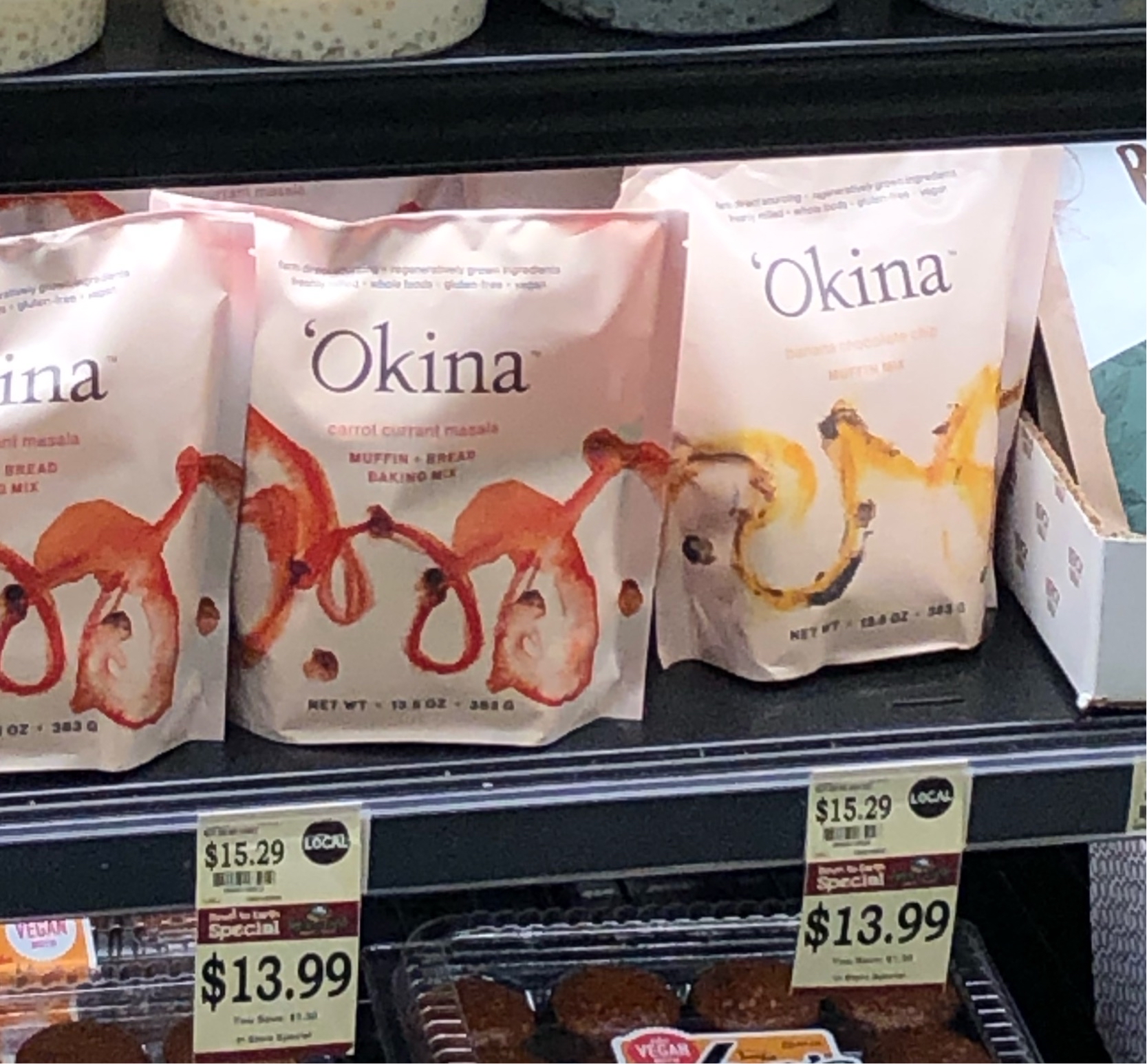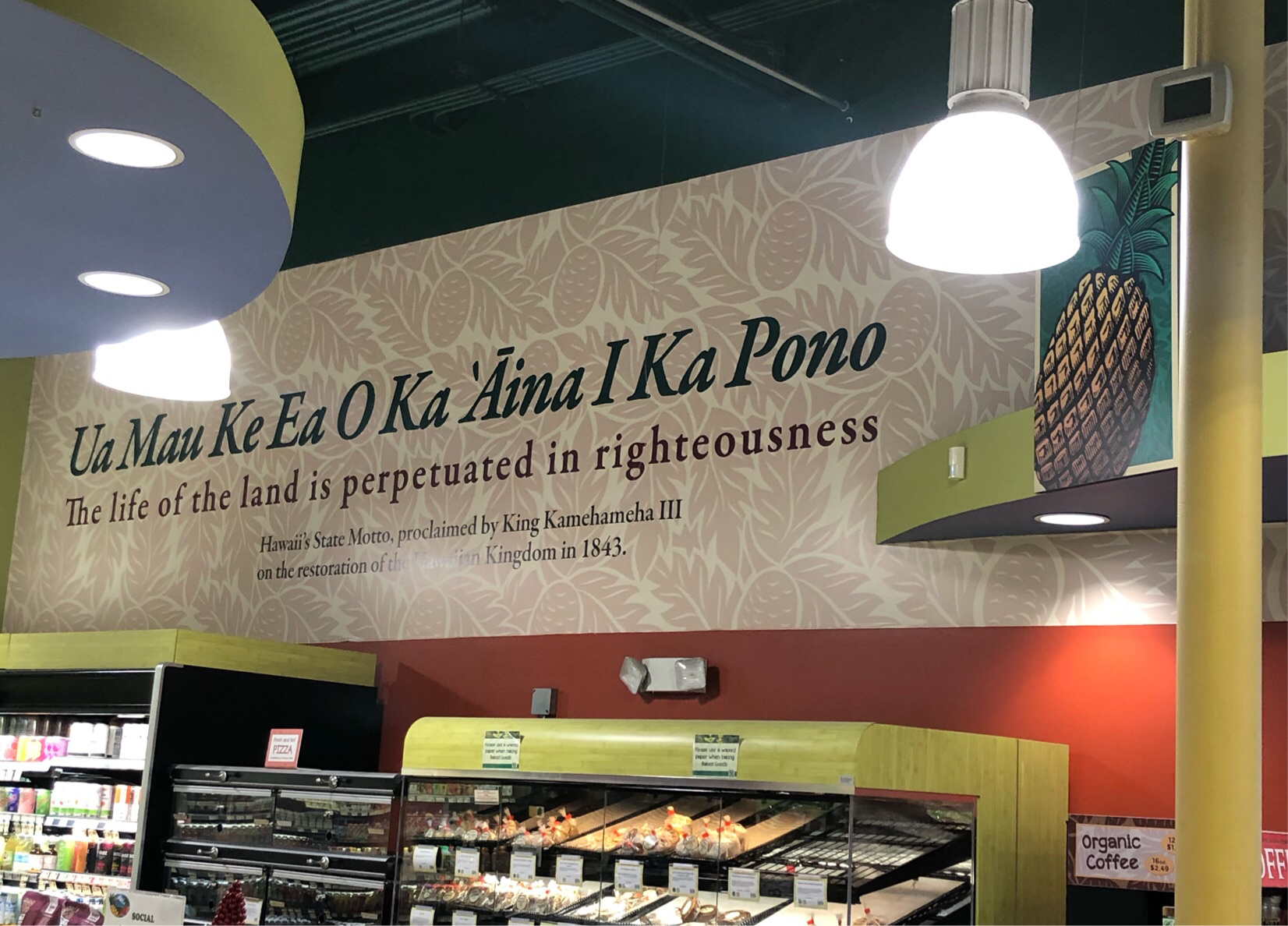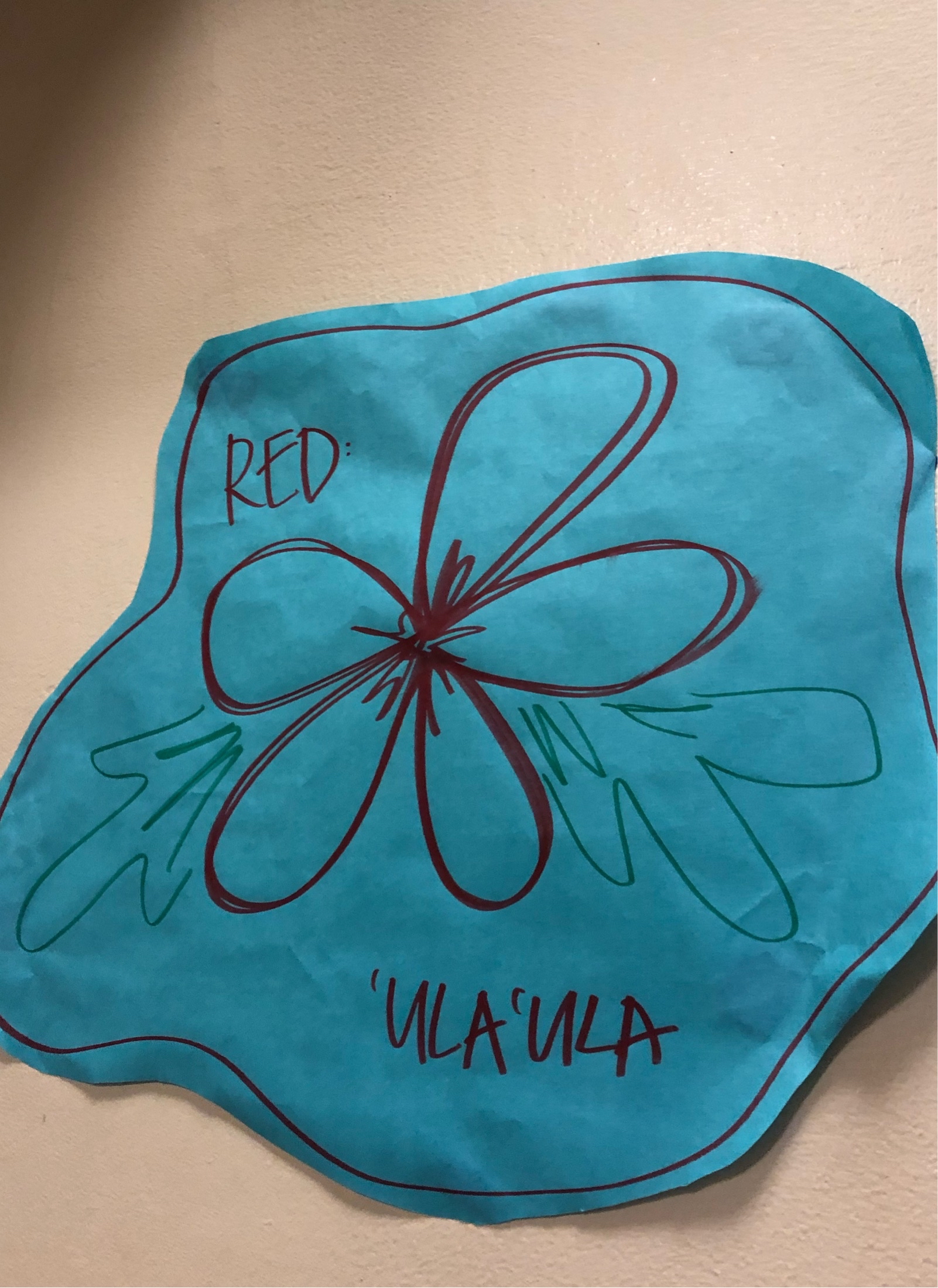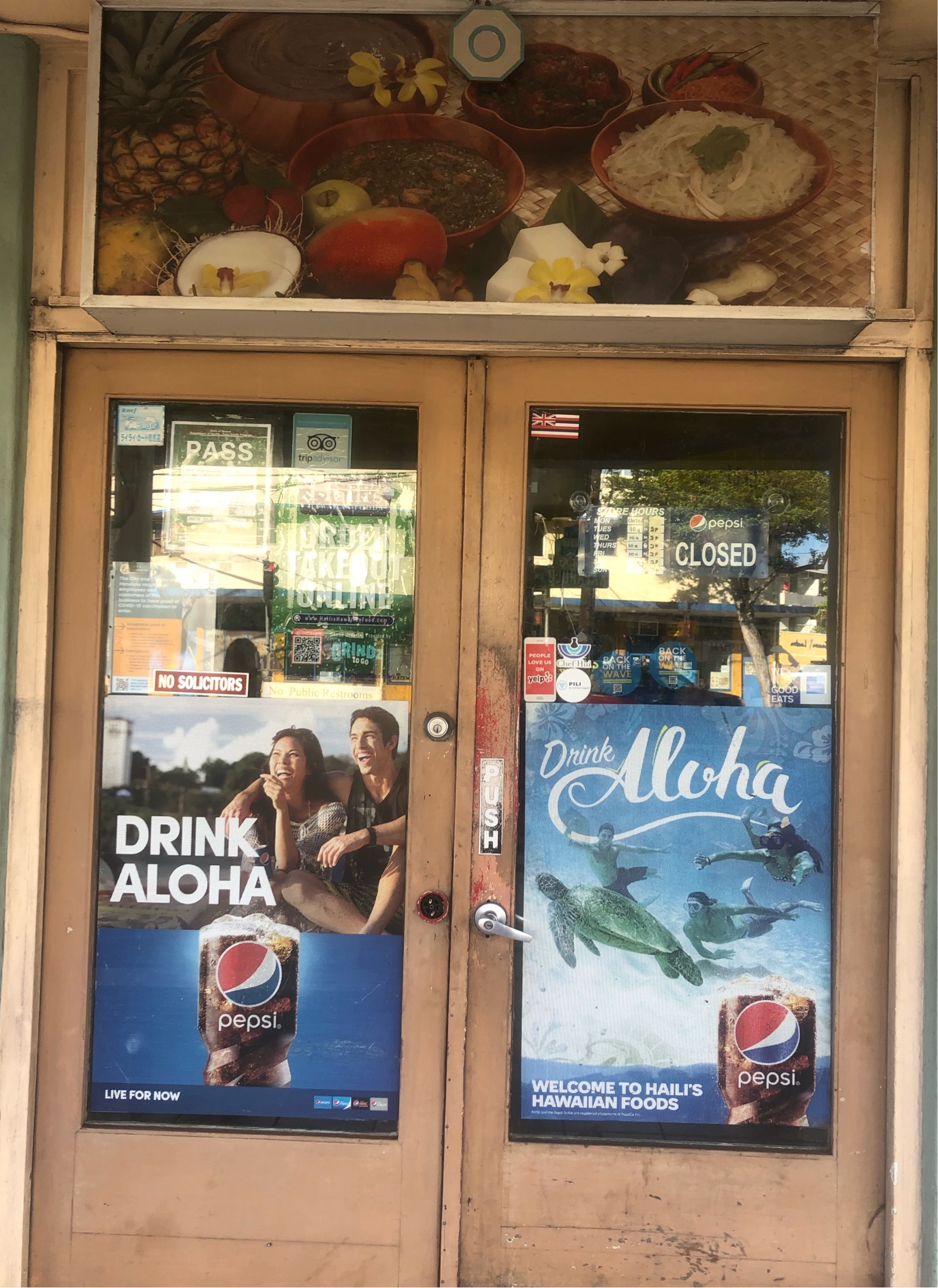|
ID |
Nickname |
Country / City |
Languages |
Taxonomies |
Comment |
Project / Group |
Map |

|
47239
|
|
United States
Aiea
|
|
|
This photo was taken in Down to Earth’s Pearlridge location. The product displayed is called “Fruit In Da Coconut,” using Pidgin. The company may be using this name to make their product seem more local or traditional. Mostly locals will see this product at the grocery store. SM
|
Multilingual Hawaiʻi
|
|

|
47238
|
|
United States
Kapolei
|
|
|
This photo was taken in the produce section of Down to Earth’s Kapolei location. The sign advertises Small Kine Farms, a local farm that Down to Earth sources produce from. The use of Pidgin suggest that Small Kine Farms is local and a small business, which would please consumers who try to shop sustainably. SM
|
Multilingual Hawaiʻi
|
|

|
47237
|
|
United States
Pearl City
|
|
|
This photo contains Pidgin, and was taken at Poke On Da Run in Pearl City. Not many tourists visit Pearl City, so Poke On Da Run seems to cater to the local demographic. They serve mostly local foods, and the Pidgin is used to contribute to this atmosphere. SM
|
Multilingual Hawaiʻi
|
|

|
47236
|
|
United States
Aiea
|
|
|
This photo was taken in Down to Earth’s Pearlridge location, displaying the brand “‘Okina.” The brand might use Hawaiian to automatically signify to consumers that they are locally owned. This is in the retail domain, and is probably seen by mostly local people. SM
|
Multilingual Hawaiʻi
|
|

|
47235
|
|
United States
Kapolei
|
|
|
This is a sign for Ili’ili Farms displayed in the produce section of Down to Earth. Signs representing the local farms that Down to Earth sources produce from are displayed throughout the section. The purpose could be to promote the farm, or to help shoppers become more conscious of where their produce comes from. The use of these signs brings awareness to local farmers and reminds customers to shop local. SM
|
Multilingual Hawaiʻi
|
|

|
47234
|
|
United States
Kapolei
|
|
|
This photo was taken at the Down to Earth grocery store in Kapolei. It says the state motto and it’s common English translation, which both have many interpretations. Many interpret the phrase as advocating for sovereignty. The domain is retail, so the company may be trying to brand themself as a positive contribution to Hawaii. SM
|
Multilingual Hawaiʻi
|
|

|
47233
|
|
United States
Kapolei
|
|
|
SM
|
Multilingual Hawaiʻi
|
|

|
47232
|
|
United States
Honolulu
|
|
|
GM - This card was at the Ala Moana target. This card says “Chee hoo” which is similar to woohoo - when you are celebrating or if something is exciting. For this card / I believe it was for a birthday.
|
Multilingual Hawaiʻi
|
|

|
47231
|
|
United States
Honolulu
|
|
|
GM- I saw this card at Ala Moana target. The targeted audience is probably locals but maybe even tourist because it is in Ala Moana which is very packed with tourist. They used pidgin in the comic an example being “what is dat smell”.
|
Multilingual Hawaiʻi
|
|

|
47230
|
|
United States
Honolulu
|
|
|
GM - This was for an event space. They used the word da room which means the room. They may have used this to attract more people to look at their place.
|
Multilingual Hawaiʻi
|
|

|
47229
|
|
United States
Honolulu
|
|
|
GM - I was at Whole Foods and this was a persons reusable grocery bag. Any kine stuff meaning all kinds of. Good bag for the grocery store
|
Multilingual Hawaiʻi
|
|

|
47228
|
|
United States
Honolulu
|
|
|
GM - Ono seafood. Ono usually means delicious. I’ve heard it’s a great seafood restaurant - very popular!
|
Multilingual Hawaiʻi
|
|

|
47227
|
|
United States
Honolulu
|
|
|
GM - this was in one of the dorm towers. This poster is trying to educate students at UH with the Hawaiian language. Red: ‘Ula’Ula
|
Multilingual Hawaiʻi
|
|

|
47226
|
|
United States
Honolulu
|
|
|
GM - I saw this while walking down to Waikiki. The intended audience is tourist / visitors. It had drink Aloha all over the posters with Pepsi on it. Just because it has a Aloha on it, I feel like it could attract visitors to drink the “aloha”
|
Multilingual Hawaiʻi
|
|

|
47225
|
|
United States
Honolulu
|
|
|
GM - I saw this sign at a Starbucks. This locations Starbucks manager was leaving and they made some notes for him. They used the word ke’eaumoku which was the name of the location of the Starbucks.
|
Multilingual Hawaiʻi
|
|

|
47210
|
|
United States
Honolulu
|
|
|
N.L
https://www.yelp.com/biz_photos/da-ono-hawaiian-foods-honolulu-4?select=J1ioHyJ5r-4zHQImNG9c9w
This is a menu from the restraint Da Ono Hawaiian Foods. The name contains the Pidgin words Da Pidgin. Da means the and Ono means delicious.
|
Multilingual Hawaiʻi
|
|

|
47209
|
|
United States
Honolulu
|
|
|
N.L
https://www.yelp.com/biz_photos/moke-s-bread-and-breakfast-kaimuki-honolulu?select=uv84NAnHkWc1uHrOmNV3qg
This photo is a restraint name that has the word Moke is the name. The word Moke is a Pidgin word that's kinda like manly.
|
Multilingual Hawaiʻi
|
|

|
47208
|
|
United States
Honolulu
|
|
|
N.L
https://www.yelp.com/biz_photos/fresh-catch-honolulu-2?select=aicGktykNZxnIyR3dPpgUA
This photo is of a menu from the restaurant Fresh Catch. The Pidgin word on this menu is Ono which means delicious.
|
Multilingual Hawaiʻi
|
|

|
47207
|
|
United States
Honolulu
|
|
|
N.L
https://www.yelp.com/biz_photos/rainbow-drive-in-honolulu?select=QpShF2XlccM6I9Tv8IiXBw
This board is the menu from a restraint called Rainbow Drive-In. It contains the Pidgin word shaka which is a hand gesture local to Hawaii.
|
Multilingual Hawaiʻi
|
|

|
47206
|
|
United States
Waipahu
|
|
|
N.L
https://www.yelp.com/biz_photos/highway-inn-waipahu?select=5ZK0GkXuJwdhswhWk5GyEQ
This photo is a flyer menu for the restaurant Highway Inn. It has the Hawaiian numbers from 1-5.
|
Multilingual Hawaiʻi
|
|